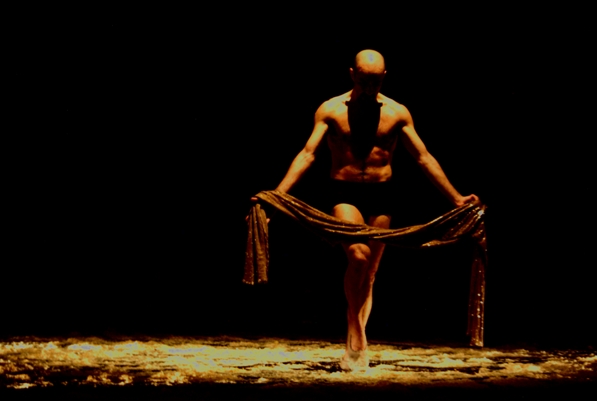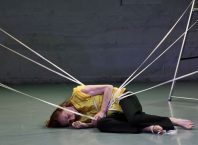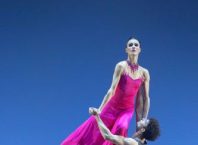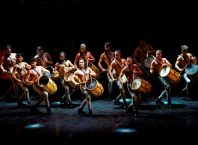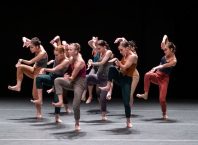The intimate and complex relationships of dance to music, dancer to pianist, the dancer and the audience were woven into Emio Greco’s Passione in Due. Bach’s St. Matthew’s Passion provided the musical theme for the performance, freely adapted by French composer Franck Krawczyk, who performed in this lovely and lively duet between dancer and pianist.
St. Matthew’s Passion is one of my favorite works, Krawczyk’s performance was beautiful and sensitive. I found the tender clarity of his voice especially moving, perhaps in part because it is surprising to have the pianist suddenly begin to sing.
It was an evening full of surprises, beginning with the stage set: on entering the hall, one immediately noticed two rows of folding chairs on either side of the stage, the piano at the center with a low table lined with glass jars full of colored liquid, and hanging above – thin rods of lights, all setting up an expectation of things to come. The chairs onstage made it clear that some audience members would be up close and personal for this performance, just how personal became apparent as the action heated up.
It is always a risk to engage the audience directly. In the context of a formal concert, one often feels that the tacit understanding is that the role of the audience is to be passive and receptive until the cue to clap, while the performer entertains. Yet for many contemporary artists, this relationship is not satisfying and they seek a more active relationship with the audience. This does not at all imply that the audience should perform with the dancer, but rather that the act of observing itself should be an active engagement with the performance. How does one elicit the audience’s engagement? Each artist creates his or her own path in this quest, whether implicit or explicit.
In this performance, Greco breaks from the conventions of the stage in several ways, exploring and highlighting relationships. Dancers are usually front and center, while the music is considered the accompaniment, and musicians are rarely seen onstage. In this instance, Krawczyk was not only playing piano, but performing onstage in movement and text, with the interaction and relationship between dancer and pianist as the central theme. Intimate, intense, playful and at times aggressive; this shared experience, this passion was eloquently conveyed.
In line with exposing those elements of a performance which are usually implied, part of the background or subtext, Greco – prompted in French by Krawczyk, also addressed the audience directly in English, opening the performance with a prologue, and eliciting the empathy and cooperation of the audience, telling those seated onstage “with your presence you give us a warm hug tonight.” More significant, he brought forward the implicit in his performance, saying: “Ladies and gentlemen, I have something extraordinarily important to tell you. My body is curious about everything, and I am my body.” Each subsequent ‘chapter’ in the evening was preceded by an explanatory introduction.
Greco is an accomplished dancer and following this suggestive introduction, the view of the glittering man in a silver body suit, dancing with an apple – the traditional symbol of knowledge and temptation – in his hand, was alluring and created an expectant tension. Each subsequent ‘chapter’ in the evening with an explanatory introduction, creating a narrative of urgency. “I need to tell you that I am not alone,” he said at a later juncture, indicating the presence of the pianist, then, the stage dark save for a spotlight on the piano, Greco stood close to the piano, only his graceful arms moving and visible in the light, dancing over the piano.
Not all parts of the evening were equally effective, some, despite the preface directing one’s attention and thoughts, did not achieve the desired effect in this viewer. Greco’s talents as a dancer are evident and pleasurable, and the entire evening was a very aesthetic experience, however, I did not feel that the movement language in itself was always compelling.
Yet Greco’s greatest risk was in the relationship to the audience, not only coming very close, but actually touching one woman, clasping her foot, and at another juncture spraying water from his mouth at such close range that splashes were inevitable. This kind of proximity may well be too much for some, one woman at last night’s performance was visibly distressed. Placing audience members onstage allows them not only to experience the performance at close range, but also, to a certain extent, to feel what the dancer might feel on that elevated, exposed terrain, giving all he’s got, body and soul. Yet I wonder: had this theme explored in an alternative manner, less direct and explicit, might its expression have ultimately been more powerful?
Passione in Due
Concept: Pieter C. Scholten, Emio Greco, Franck Krawczyk; Choreography: Emio Greco, Pieter C. Scholten; Music: J.S. Bach’s St. Matthew’s Passion in a free adaptation by Franck Krawczyk; Performers: Emio Greco (dance) and Franck Krawczyk (piano, accordion).
Performances took place May 6 & 7th, 2013 at the Suzanne Dellal Centre in the context of the Tel Aviv Dance Festival. Read more about Tel Aviv Dance here, further information and tickets on the Suzanne Dellal website.

